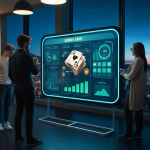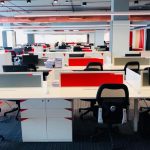The modern office has evolved beyond cubicles and rigid desk arrangements. Today, workplaces are designed with flexibility, wellness, and innovation at their core. Businesses are embracing new furniture trends that align with changing work dynamics, employee well-being, and sustainable practices. Let’s explore the latest insights from office design experts that are shaping modern workspaces.
1. Hybrid Work-Ready Spaces
The shift towards hybrid work has made adaptability a priority. Offices are no longer solely dedicated to traditional desks; instead, they feature dynamic work environments that cater to both remote and in-office employees. Modular furniture solutions, such as movable desks, adjustable workstations, and multi-functional tables, allow seamless transitions between collaborative meetings and focused solo work.
2. Ergonomic Evolution
Ergonomic office furniture has been around for some time, but the focus has shifted from mere comfort to holistic health. Standing desks with height adjustability, active seating options like balance ball chairs, and anti-fatigue mats are becoming essentials in the modern workspace. Employers are investing in posture-friendly solutions that boost productivity and reduce physical strain.
3. Biophilic Integration
Bringing nature indoors is a trend that continues to grow. Biophilic design incorporates natural elements like wooden desks, indoor plant walls, and organic materials to foster a calming and inspiring work atmosphere. Studies show that greenery and nature-inspired aesthetics enhance employee focus and mental well-being, making biophilic office furniture a must-have.
4. Tech-Integrated Workstations
Technology is deeply woven into today’s work culture, and furniture is catching up. Smart desks with built-in wireless charging, integrated cable management, and IoT-enabled features are becoming standard. Conference tables with embedded power outlets and digital collaboration tools streamline workflow and eliminate clutter, creating a tech-friendly workspace.
5. Collaborative & Social Zones
Gone are the days when office interactions were confined to boardrooms. Modern workspaces emphasize collaboration through designated social zones. Lounge-style seating, shared worktables, and soundproof pods create versatile areas where employees can engage in teamwork or take informal breaks, fostering a more connected work environment.
6. Sustainability and Eco-Conscious Choices
Sustainability is now a major driver in office furniture trends. Companies are opting for furniture made from recycled materials, FSC-certified wood, and low-VOC finishes. Circular economy practices, such as upcycling old office furniture and using modular, repairable designs, are shaping sustainable workplace solutions.
7. Personalized & Customizable Spaces
Employees crave a sense of ownership in their workspace. Customizable office furniture, such as adjustable partition panels, color-coordinated desks, and interchangeable decor elements, gives individuals the freedom to tailor their workstations. This personalization enhances comfort, satisfaction, and a sense of belonging in the office.
8. Acoustic Considerations
As open-plan offices dominate, noise control has become essential. Acoustic panels, upholstered booths, and sound-absorbing furniture pieces help reduce distractions and create quieter zones. Many businesses are integrating acoustic-friendly furniture designs to balance collaboration with focused work.
9. Resimercial Aesthetics
Blurring the line between residential and commercial design, “resimercial” furniture is trending. Soft textures, plush seating, and homely touches create a more inviting and relaxed workspace. This approach fosters a comfortable environment that enhances creativity and reduces workplace stress.
10. Color Psychology in Furniture
Colors influence emotions and productivity. Office furniture is no longer limited to dull neutrals; designers are incorporating energizing hues like blues for focus, greens for calmness, and warm tones for creativity. The right color palette in furniture selections contributes to an engaging and stimulating work environment.
The Future of Office Furniture
The office furniture landscape is evolving to meet the diverse needs of today’s workforce. As hybrid work continues to shape the future, flexible, ergonomic, and tech-savvy furniture will be at the forefront of office design. Businesses that invest in thoughtful workspace solutions will cultivate a more productive, engaged, and satisfied workforce.
By embracing these trends, companies can create workspaces that are not only aesthetically appealing but also functional, sustainable, and conducive to employee well-being.







